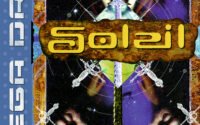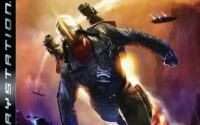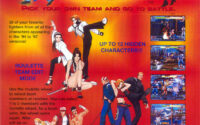Etrian Odyssey Review
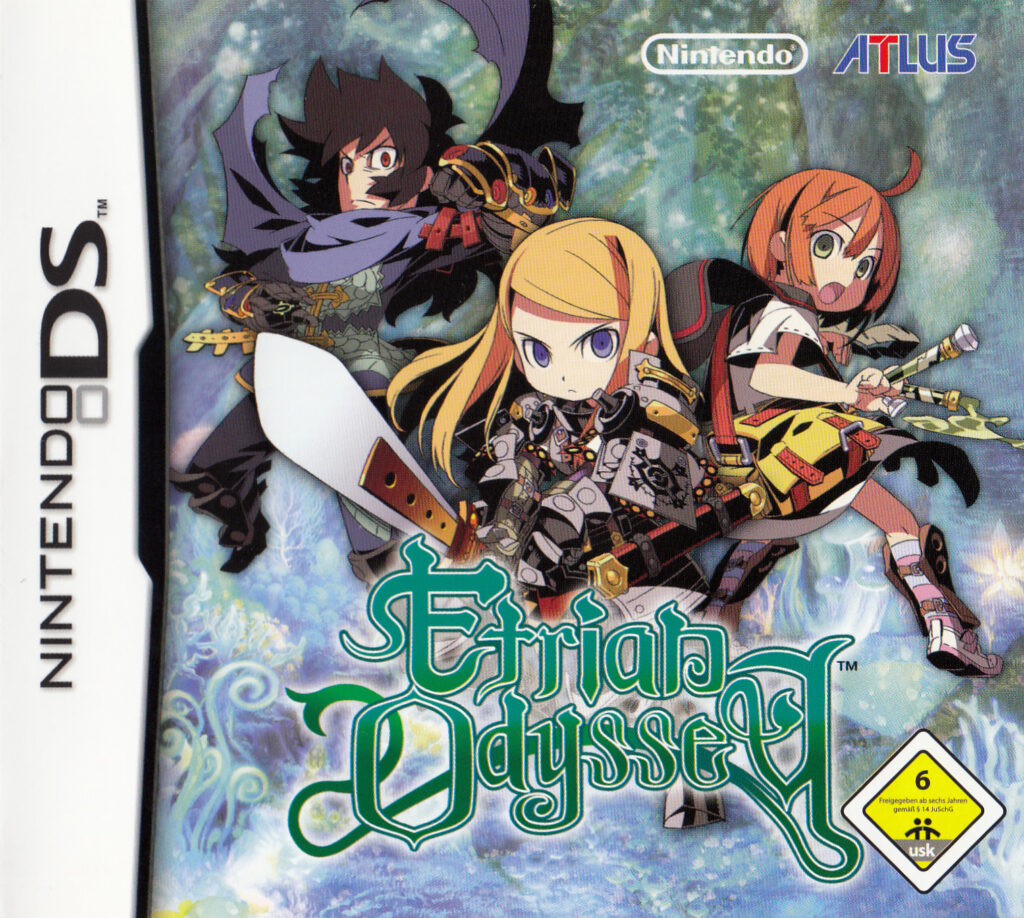
Create your own heroes and explore a mysterious labyrinth filled with monsters and treasure.
Story
The people of the town Etria has since some time ago found a hidden forest labyrinth not too far from the city gates. Since the discovery there has been numerous myths, rumors, legends and tales told about the fabled dangers that lie therein. The town sees a flow of brave adventurers who seek to explore the deeper depths of the labyrinth to find answers to its mysteries. It soon becomes known that the labyrinth has many levels and continues on deep below ground surface – and the monsters there put an end to the exploration. The town administration officially announces that any adventurer who is willing to contribute to the exploration and mapping of the labyrinth will be generously rewarded.
The guild hall becomes a hub for would-be heroes seeking like-minded partners to tackle the deadly monsters to become famous and rich. Will the heroes be able to unwrap the ancient mysteries that hide in the depths?
The Game
Etrian Odyssey is a first-person roleplaying game in which you guide an adventuring guild into the large, forbidding labyrinth. Your quest consists of drawing maps, contributing with information to the official monster- and item compendiums, doing side quests, crafting items, recruiting adventurers and of course slaying monsters of the labyrinth. This in turn will make you great heroes and eventually you’ll be able to solve some of the mysteries concerning the labyrinth.
Content
One prominent feature of this game is that it allows you to create your own heroes and build your own party constellations right from the beginning. There’s a guild hall in the town where you can create characters as well as delete them. Your adventuring party can only hold five heroes at most, but you can swap party members freely whenever you visit the guild hall. This could be useful if you, for example, have built a party consisting mostly of fighters and knights but encounter monsters that are weak to magic attacks. Then you could consider taking along a magic user.
Newly created characters are, of course, weaker than venerable heroes, so in that case you’d have to bring the low-level character to fight monsters so that it earns some experience points. This can be very tedious, so you’re better off creating a well-balanced and multi functional party right from the beginning. But even then you won’t be completely covered because you will get access to new character classes further in the game. If you want to have that competence in your party you must create a new character of that class and go from there.
The playable character classes are; Landskencht, Protector, Dark Hunter, Survivalist, Medic, Alchemist, Troubadour, Ronin and Hexer. As you can see, most imaginable RPG archetypes are covered even though the classes aren’t exactly stereotypical.
When you first enter the labyrinth you’ll see that the lower screen of the DS is used to display an overhead map of the surroundings. You can at any time draw walls on this map to make out the dungeon layout. You can also add notes and special markers for different points of interest that you may find. Mapping the dungeon is a central part of the game because without it it’s close to impossible to navigate in the dungeon.
The top screen of the DS is where you see the dungeon in first person view. It should be said that the whole game is based on a grid system, so one step is represented by one square on the grid system. Drawing the map is done with the stylus and it works effortlessly.
In the beginning the game is very harsh. Your newly created party is very fragile and weak compared to the monsters. Keeping up costs for the party (healing medicines etc) is hard until you manage to kill a monster that yields valuable loot. This means that it will take at least a few hours of playing before you’ve got your costs covered with marginals.
Loot found in the dungeon can be sold in the weapon shop. The so called item crafting in this game is simply done by selling materials you find. You can find materials by either killing monsters or collecting resources. Once you sell enough of a material that’s needed for an item it will be made available in the shop. The game is very secretive about what materials are needed though, so unless you have a game guide, the item crafting is a guessing game that really isn’t worth the time – instead the standard practice is to sell everything you find in hopes to unlock new items. Since your inventory space is limited anyway this is really the only viable choice you have.
Like many other RPG games your characters grow in strength the more experience points they collect. For each level your characters rises you may allocate skill points on a skill that you want to learn or raise. Each character class has its own specific skills, so there is quite a lot to discover there. The classes are quite well-balanced when compared to each other but certain skills stand out as overly powerful such as the Survivalist’s “Multihit” that strikes up to three foes in one attack. Other skills such as the Protector’s “F.Guard” and “B.Guard” skips your turn for a chance to take damage in place of someone standing in the front- or back line respectively, is more or less worthless because the chance for it to actually come in effect is so small.
Sadly there’s no way of knowing what skills are worth getting for your characters, so you’re encouraged to experiment. If you train your characters enough you’ll eventually have enough skill points to max out the skills that you find useful anyway.
When playing this game you’ll notice that boss monsters and mini bosses are extremely hard to defeat. This typically means that your characters aren’t strong enough, so you’re often stuck killing lower level monsters for hours before your characters have gained enough experience (and skills) to stand a chance against the said boss monster. This is a pattern that follows you though out the entire game, and it’s a problem even if you never switch out your characters in your party! With that said, it’s clear that this game requires lots of monster slaying in order to be able to make progress in the story.
Every time you visit the town you’ll be able to save your progress. You should save as often as possible, because every single bit of progress you make is important to secure. It should be noted though that the game only has support for one save slot. If you want to share the game with someone you could in theory make two different adventuring parties on the same guild and that way co-operate through the game, but that’s a solution most people probably will find too far fetched.
Your party members can be resurrected if they should fall in battle. There’s a hefty fee to pay for this though, so you better make sure to have enough En’s (the currency in the game world) to cover the cost. If your entire party gets wiped out, the game is over. But here’s a unique feature of the game; you get to keep changes and updates that you have made to your map. In other words, you won’t need to explore and map the same area twice even if you happen to wipe out and load the game from your last save.
Poisoning in this game is absolutely deadly. You can’t help but to think that they’ve misjudged the strength of the poisons in this game. Poisoning in Etrian Odyssey is like in many other games a status effect that deals damage over time – but here the amount of damage is often enough to bring your character down in one, two or three turns. This means that you really need a Medic class character in your party, because they can learn the ability to rid poisons from the party. But considering the amount of damage your party suffers from general monster slaying you really need a Medic anyway.
The battles are turn based and in essence very simple. You select actions for each of your party member (what monster to attack or what skill to use etc) for the coming turn, and you then watch how your selected actions turn out. You can’t see what order your characters and the monsters get to act in, so you can’t really plan your course of actions in any detail – you simply have to take risks or depend on your luck.
You can fast forward the turn by simply holding the B button. This helps during those prolonged monster slaying sessions, but isn’t enough to make it a pleasant experience – the game is still pretty slow.
Other than mindless monster slaying your guild may engage in completing quests and missions for the town. Missions play a key role in the game because you need to complete them in order to gain access to new levels of the labyrinth. The dialogue in the game sometimes makes it sound like you have a choice – to do the mission or not. But in reality there is no choice. You must accept and complete the missions in order to make progress in the game.
Quests on the other hand are optional and sadly never worth doing. The quests are often very demanding and obscure even, and the rewards are pathetic; they often reward you with small amounts of En, that you could otherwise easily earn by simply selling loot in the store. There are lots of different optional quests in the game and the story behind them does deepen the lore of the labyrinth – but as stated above; I never found them to be worth the trouble.
In the town you will be able to report your progress to the city authorities. They will keep track of all the items and monsters you have encountered during your adventures. The compendiums contain some information about any given item or monster, and the game automatically updates it for you. Further more the compendiums reveal that there are almost 200 different items and about 130 different monsters in the game. It should be noted though, that multiple monsters look the same with only changes to their colors.
Etrian Odyssey is a lengthy game there’s no doubt about it. The labyrinth has 30 floors for you to explore across five different settings; you’ll get to explore a lush forest, a jungle, aquatic domains and sand barrens. To get though the game you would have to play for weeks – not only is the game lengthy but there are also numerous occasions when you get stuck either because you need to level up your characters or you can’t find where you’re supposed to go. The labyrinth as many secret areas and treasures, so exploring the game thoroughly is a daunting task indeed – it will probably take 80+ hours.
Graphics
Visually Etrian Odyssey is pretty basic. The first person camera does give you a 3D view of the labyrinth, but there really isn’t much to see because all the walls do look the same on any given level of the labyrinth. There are five different settings within the labyrinth and the change is nice and helps in keeping things fresh. But you won’t be able to navigate within the labyrinth without looking at the map.
During battles you’ll see the monsters you fight standing in front of you. Even the battles do have a simplistic look – there’s virtually no animation other than the damage numbers that indicate how much damage each attack causes.
Sound
The music in the game is pretty good. The game has a typical JRPG sound to it with catchy and cheery songs. The music does give the game a distinct atmosphere, as there are mystical tunes in there too. The song that plays during the battles in the first few floors of the dungeon stand out as iconic to the game and will probably stick in the player’s head forever. Listening to the same songs for hours on end will be obviously be tiring though. The sound effects are generic and even on the simple side, which does nothing to really uplift the general experience.
Summary
Etrian Odyssey is pretty much a hardcore RPG. It’s very hard and demands hours of mindless monster slaying. The premise of the story is interesting but I found the plot that develops during the game to be rather bland.
Drawing maps and exploring dungeons is always fun and this game has a lot of that. Yes, the game is repetitive and now and then it’s boring even. To spice it up there are numerous character classes to experiment with and lots of monsters, traps and treasures to find.
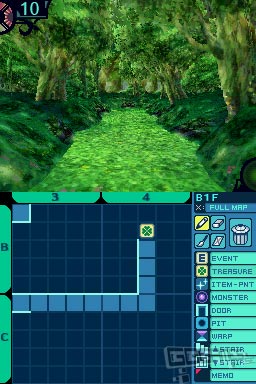
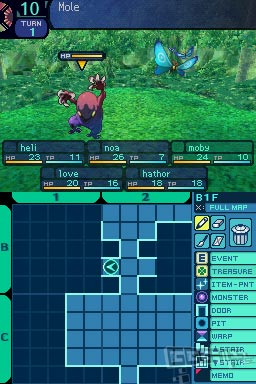
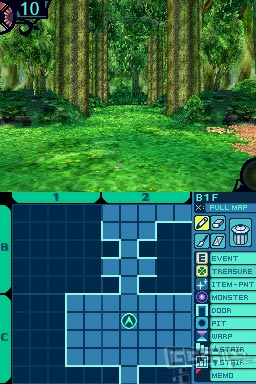
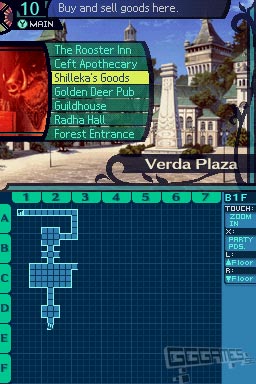
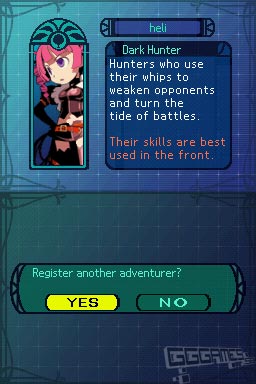
Developed By: Atlus
Published By: Nintendo
Version Reviewed: Nintendo DS
Genre: Roleplaying
Players: 1
Released: 2008-06-06
About The Author
Mattias
Played my first video game in the 80's on the Commodore 64, and have been hooked since then. Loved the 16-bit era, the glossy magazines, and the colorful arcade games from that time.

